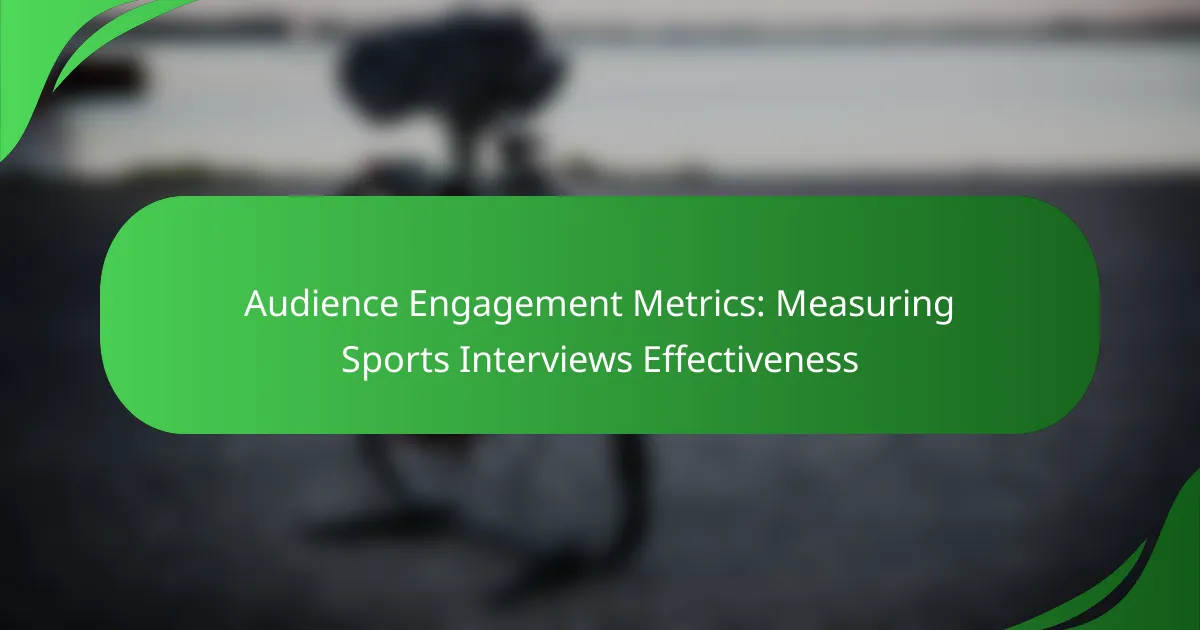In the realm of sports interviews and engagement, utilizing effective audience feedback tools is essential for understanding fan preferences and enhancing their experiences. Tools like SurveyMonkey, Qualtrics, Typeform, and Google Forms offer unique features that facilitate real-time feedback and in-depth analysis. By leveraging these insights, sports organizations can better tailor their offerings to meet audience expectations and foster deeper connections with fans.

What are the best audience feedback tools for sports interviews in the UK?
The best audience feedback tools for sports interviews in the UK include SurveyMonkey, Qualtrics, Typeform, and Google Forms. Each tool offers unique features that cater to different needs, such as real-time feedback, in-depth analysis, engaging formats, and quick polling options.
SurveyMonkey for real-time feedback
SurveyMonkey is ideal for collecting real-time feedback during sports interviews. Its user-friendly interface allows interviewers to create and distribute surveys quickly, gathering responses almost instantly.
Consider using SurveyMonkey’s templates specifically designed for sports events to streamline your survey creation. The platform also offers analytics tools to help interpret the feedback efficiently, making it easier to adjust strategies on the fly.
Qualtrics for in-depth analysis
Qualtrics excels in providing comprehensive insights through its advanced analytics capabilities. This tool is suited for teams looking to delve deeper into audience sentiments and preferences following interviews.
With features like sentiment analysis and customizable reporting, Qualtrics allows sports organizations to track changes over time and understand the nuances of fan engagement. However, it may require a steeper learning curve compared to simpler tools.
Typeform for engaging surveys
Typeform stands out for its visually appealing and interactive survey designs, making it a great choice for engaging audiences during sports interviews. The conversational format encourages higher completion rates.
Utilize Typeform’s logic jumps to tailor questions based on previous answers, enhancing user experience. This tool is particularly effective for capturing qualitative feedback, which can provide richer insights into fan experiences.
Google Forms for quick polls
Google Forms is a straightforward option for conducting quick polls related to sports interviews. It allows for easy setup and sharing, making it accessible for teams of all sizes.
While it may lack some advanced features of other tools, Google Forms is efficient for gathering immediate feedback. Its integration with Google Sheets also enables simple data analysis, which can be beneficial for quick decision-making.

How can audience feedback improve sports engagement?
Audience feedback plays a crucial role in enhancing sports engagement by providing insights into fan preferences and experiences. By actively collecting and analyzing this feedback, sports organizations can tailor their offerings to better meet the needs and expectations of their audience.
Enhances fan experience
Gathering audience feedback allows sports teams to understand what fans enjoy most about their experience, whether it’s game-day atmosphere, merchandise, or digital content. For instance, surveys can reveal preferences for certain types of entertainment during breaks or preferred food options at stadiums.
Implementing changes based on feedback can lead to a more enjoyable experience, increasing attendance and overall satisfaction. Teams might consider using mobile apps to facilitate real-time feedback during games, allowing for immediate adjustments to enhance the fan experience.
Informs content strategy
Audience feedback is essential for shaping a sports organization’s content strategy. By analyzing what types of content resonate with fans—such as behind-the-scenes videos, player interviews, or highlight reels—teams can create more engaging and relevant material.
For example, if feedback indicates a strong interest in player stories, teams can prioritize producing more of this content across their social media channels. Regularly reviewing feedback helps ensure that content remains fresh and aligned with fan interests, ultimately driving higher engagement rates.
Boosts team loyalty
When fans feel their opinions are valued and acted upon, their loyalty to the team increases. Audience feedback can be used to identify areas where teams can improve their relationship with fans, such as enhancing communication or offering personalized experiences.
For instance, loyalty programs that reward fans for providing feedback can foster a deeper connection. By actively engaging with fans and demonstrating that their input leads to tangible changes, teams can cultivate a loyal fan base that is more likely to support the team financially and emotionally.

What are the key features to look for in feedback tools?
Key features to consider in feedback tools include usability, the ability to provide real-time data, and seamless integration with social media platforms. These elements enhance the overall effectiveness of gathering and analyzing audience feedback during sports interviews and engagements.
User-friendly interface
A user-friendly interface is crucial for ensuring that both interviewers and audiences can navigate the feedback tool easily. Look for intuitive designs that minimize the learning curve, allowing users to focus on providing and analyzing feedback rather than struggling with the software.
Consider features like drag-and-drop functionality, clear navigation menus, and mobile compatibility. Tools that offer customizable dashboards can also enhance user experience by allowing users to prioritize the information that matters most to them.
Real-time analytics
Real-time analytics enable immediate insights into audience feedback, which is essential for timely adjustments during sports interviews. Look for tools that provide instant data visualization, such as charts and graphs, to quickly interpret audience reactions.
Effective real-time analytics should include metrics like engagement rates and sentiment analysis. This allows interviewers to adapt their approach based on audience responses, enhancing the overall interaction and engagement quality.
Integration with social media
Integration with social media platforms is vital for expanding the reach of feedback tools. Look for solutions that allow seamless sharing of feedback results across platforms like Twitter, Facebook, and Instagram, enabling broader audience engagement.
Additionally, consider tools that allow audience members to submit feedback directly through social media channels. This not only simplifies the feedback process but also encourages participation from a wider demographic, increasing the overall volume and diversity of responses.

What are the challenges of using audience feedback tools?
Using audience feedback tools presents several challenges, including data privacy concerns, low response rates, and the potential for misinterpretation of data. Addressing these issues is crucial for effectively gathering and utilizing audience insights in sports interviews and engagement strategies.
Data privacy concerns
Data privacy is a significant challenge when using audience feedback tools, as users are increasingly aware of how their information is collected and used. Ensuring compliance with regulations like GDPR in Europe or CCPA in California is essential to maintain trust and avoid legal repercussions.
To mitigate privacy concerns, organizations should be transparent about data usage, obtain explicit consent, and implement robust security measures. Regularly reviewing privacy policies and practices can help build confidence among participants.
Low response rates
Low response rates can hinder the effectiveness of audience feedback tools, making it difficult to gather representative insights. Factors such as survey length, timing, and perceived value can influence participation levels.
To improve response rates, keep surveys concise and relevant, offer incentives, and ensure they are distributed at optimal times. Engaging audiences through multiple channels, like social media or email, can also enhance participation.
Misinterpretation of data
Misinterpretation of data is a common issue that can lead to misguided conclusions and strategies. This often occurs when feedback is taken out of context or when data is analyzed without considering external factors.
To avoid misinterpretation, use clear metrics and benchmarks for analysis, and involve multiple stakeholders in the review process. Providing training on data literacy for team members can also help ensure that insights are accurately understood and applied.

How to effectively implement audience feedback tools in sports?
To effectively implement audience feedback tools in sports, it’s essential to establish a clear strategy that aligns with your goals. This involves selecting the right tools and methods to gather insights from fans and stakeholders, ensuring their voices are heard and valued.
Define clear objectives
Establishing clear objectives is crucial for the successful implementation of audience feedback tools. Determine what specific information you want to gather, such as fan satisfaction, engagement levels, or event experiences. This clarity will guide your choice of tools and metrics.
Consider setting measurable goals, like increasing fan engagement by a certain percentage or improving satisfaction ratings. This will help you assess the effectiveness of your feedback initiatives and make necessary adjustments over time.
Engage stakeholders
Engaging stakeholders is vital for the successful adoption of audience feedback tools. Involve team members, sponsors, and fans in the planning process to ensure their perspectives are considered. This collaborative approach fosters a sense of ownership and encourages participation.
Utilize various channels to communicate with stakeholders, such as social media, surveys, and focus groups. Regularly update them on how their feedback is being used to enhance the sports experience, which can further strengthen their engagement and loyalty.



